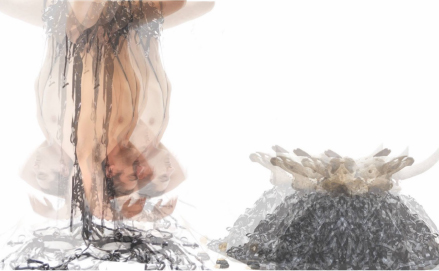Suspension of control matrices through touch
DOI:
https://doi.org/10.54104/nodo.v19n38.2177Keywords:
Arte, Artechnic, electronic art, Generative Art, artificial intelligence, touchAbstract
This research-creation project emerges from an expanded notion of touch —understood as a specific, performative practice within multimedia art— as both movement and interface that generates worlds. I propose that this approach holds the potential to increase happiness by liberating us from certain control matrices. Through touch —fundamentally a relational act— I explore modes of mediating existence and transforming it (while simultaneously transforming ourselves) via a broad spectrum of techniques, procedures, machines, and arts. This work begins with suspension as an action that disrupts the Cartesian segmentation of the senses as distinct categories, aiming to expand the inquiry into the relationships between artistic practices and happiness, and between image and technique-technology. To this end, I introduce the concept of artécnica (art-technique), conceived as a way to establish an indispensable dialogue between making and thinking. The research seeks to deepen our understanding of this relationship and the potential of practice to transmute “difficulties into means”. Adopting an experiential, situated-knowledge approach, I engage with concepts drawn from sociology and art theory, as well as those generated at the intersection of art and technique. Suspensión investigates the political-affective dimension of electronic arts and explores haptics as a gateway to alternative modes of perception.
Downloads
References
Bardet, Marie (2021). Perder la cara. Buenos Aires: Cactus.
Deleuze, Gilles (1995). Conversaciones 1972-1990. Valencia: Pre-Textos.
Kozak, Claudia (2007). Arte y técnica. Vilém Flusser sobre arte, aparatos y funcionarios. Artefacto, 6.
Kozak, C. (comp.). (2014). Poéticas/políticas tecnológicas en Argentina (1910-2010). Paraná: La Hendija.
Kusch, R. (1995). Anotaciones para una estética de lo americano. BOA: Revista de la Facultad de Bellas Artes, UNLP, 15 (11).
Lepecki, Andre (2006). Agotar la danza. Performance y política del movimiento. España: Centro Coreográfico Galego.
Manning, Erin (2007). Politics of Touch: Sense, Movement, Sovereignty. Minnesota: University of Minnesota Press.
Sekula, A. [1989] 1997. Archivar rostros. El cuerpo y el archivo. En Gloria Picazo (ed.), Indiferencia y singularidad. La fotografía en el pensamiento artístico contemporáneo. MACBA: https://laongbuenosaires.com/wp-content/up loads/2020/06/Alan-Sekula.pdf
Scolari,Carlos (2018). Las leyes de la interfaz. Buenos Aires: Gedisa.
Simondon, G. (2012). On techno-aesthetics (A. De Boever, trans.). Parrhesia, 14, 1-8.
Tripaldi, Laura (2023). Mentes paralelas. Descubrir la inteligencia de los materiales. Buenos Aires: Caja Negra.
Yeregui, Mariela (2008). Postvideo. Las artes mediáticas de la Argentina en la era digital. En La Ferla, Jorge (2008). Historia crítica del video argentino. MALBA-Espacio Fundación Telefónica.
Modelar rostros
Dondero, M. G. (2023). La herencia de Warburg y Focillon: una genealogía de las formas visuales en el análisis computacional. En Martín Acebal, Cristina Voto (eds.) Archivo y memoria. DeSignis: https://www.designisfels.net/wp-content/uploads/2023/12/designis-i39p159-172.pdf
Diseñar datos faciales
Voto, C. 2022. La sexualidad del rostro: revelación artificial y desprogramación material. En Cristina Peñamarín, Beatriz Amman y Elizabeth Parra (eds.). Semiosis y feminismos. Teorías feministas y del discurso. DeSignis: https://www.designisfels.net/capitulo/i36-11-la-sexualidad- del-rostro-revelacion-artificial-ydesprogramacion- material/

Downloads
Published
-
Abstract423
-
PDF (Español)254
How to Cite
Issue
Section
License
Copyright (c) 2025 Juan Miceli Mazzei

This work is licensed under a Creative Commons Attribution-NonCommercial-ShareAlike 4.0 International License.



 Portal de Ciencia Abierta
Portal de Ciencia Abierta